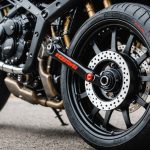Your Ultimate Guide to Installing a Sport Bike Tire Pressure Monitoring System: Achieve Real-Time Pressure Awareness with These Easy Steps
Why You Need a Tire Pressure Monitoring System (TPMS) for Your Bike
When it comes to riding a sport bike, safety and performance are paramount. One often overlooked but crucial aspect of bike maintenance is tire pressure. Proper tire pressure can significantly impact your bike’s handling, traction, and overall safety. A Tire Pressure Monitoring System (TPMS) is an invaluable tool that helps you maintain the perfect pressure for your bike tires, ensuring you get the best out of your riding experience.
“Maintaining the optimal tire pressure is essential for the safety and efficiency of your vehicle,” as emphasized by Continental Tires[2]. This principle applies just as much to bikes as it does to cars, and a TPMS can be a game-changer for riders.
Also to discover : Unlocking tank grip techniques: elevate your sport bike handling skills in the uk
Understanding How TPMS Works
Before diving into the installation process, it’s important to understand how a TPMS works. A typical TPMS consists of sensors attached to each wheel that monitor the air pressure in real-time. These sensors transmit data to a central display unit, usually mounted on the bike’s dashboard or handlebars.
Here’s a breakdown of the key components:
In parallel : Essential sport bike glove selection for optimal grip in challenging uk wet weather conditions
- Pressure Sensors: These are the heart of the TPMS, attached to the valve stem of each tire. They measure the air pressure and send the data wirelessly to the display unit.
- Display Unit: This is where you see the real-time pressure readings for each tire. It often includes alerts for underinflated tires, battery levels, and other critical information.
- Battery Life: Most TPMS sensors are battery-powered, with battery life ranging from 2 to 5 years depending on the model.
Preparing for Installation
Before you start the installation process, make sure you have all the necessary tools and components. Here’s a checklist to get you started:
Tools Needed:
- Tire levers
- Wheel chocks
- Torque wrench
- Screwdriver or Allen wrench
- Battery tester (if applicable)
Components Needed:
- TPMS sensors
- Display unit
- Mounting hardware (clamps, screws, etc.)
- User manual
Step-by-Step Installation Guide
Installing a TPMS on your sport bike is relatively straightforward, but it does require some attention to detail. Here’s a step-by-step guide to help you through the process:
1. Choose the Right Location for the Sensors
Ensure the sensors are compatible with your bike’s tire valves. Most sensors are universal, but it’s always good to double-check.
2. Remove the Valve Caps
Take off the valve caps to expose the valve stems where the sensors will be attached.
3. Install the Sensors
Screw the TPMS sensors onto the valve stems. Make sure they are securely attached but not over-tightened, which could damage the valve stem.
4. Mount the Display Unit
Choose a convenient location for the display unit, such as the handlebars or dashboard. Use the provided mounting hardware to secure it firmly.
5. Pair the Sensors with the Display Unit
Follow the manufacturer’s instructions to pair each sensor with the display unit. This usually involves a simple calibration process.
6. Test the System
Inflate your tires to the recommended pressure and check the readings on the display unit. Ensure all sensors are transmitting data correctly and that the display unit is showing accurate readings.
Advanced Features to Look For
While the basic function of a TPMS is to monitor tire pressure, many modern systems come with advanced features that can enhance your riding experience:
Real-Time Alerts
Receive immediate alerts if any tire drops below the set pressure threshold, ensuring you can take action before it affects your ride.
Multiple Tire Profiles
Store different tire profiles for different riding conditions or bikes, making it easy to switch between setups.
Temperature Monitoring
Some TPMS systems also monitor tire temperature, which can be crucial for high-performance riding where tire heat can affect handling.
Bluetooth Connectivity
Some advanced TPMS systems can connect to your smartphone via Bluetooth, allowing you to monitor your tire pressures remotely.
Practical Tips and Considerations
Here are some practical tips to keep in mind when using a TPMS on your sport bike:
Regular Calibration
Regularly calibrate your TPMS to ensure accuracy. This is especially important if you change tires or adjust the pressure frequently.
Battery Maintenance
Check the battery levels of your sensors regularly. Most systems will alert you when the batteries are running low, but it’s good practice to keep spare batteries on hand.
Riding Style Adjustments
Adjust your tire pressures based on your riding style. For example, if you’re doing track days, you may need lower pressures for better traction.
Seasonal Adjustments
Adjust your tire pressures according to the season. For instance, colder temperatures may require higher pressures to maintain optimal performance[5].
Comparison of Popular TPMS Systems
Here’s a comparison table of some popular TPMS systems available for sport bikes:
| System | Number of Sensors | Display Type | Additional Features | Battery Life | Price Range |
|---|---|---|---|---|---|
| My TPMS | 4 | LCD Display | Real-Time Alerts, Multiple Profiles | 2-3 Years | $100-$200 |
| Continental TPMS | 4 | Digital Display | Temperature Monitoring, Bluetooth Connectivity | 3-5 Years | $200-$300 |
| Temu TPMS | 4 | LED Display | Real-Time Alerts, Multiple Profiles | 2-3 Years | $80-$150 |
Quotes and Insights from Experts
“Les applications de surveillance de la pression des pneus n’est pas seulement une question de commodité, mais peut également apporter de réels avantages pour votre sécurité et votre portefeuille,” according to an expert from Pneumatici Diretti[1]. This applies equally to bikes, where maintaining optimal tire pressure can enhance safety and performance.
Common Mistakes to Avoid
When installing and using a TPMS, here are some common mistakes to avoid:
- Incorrect Sensor Installation: Ensure the sensors are securely attached to the valve stems but not over-tightened.
- Ignoring Alerts: Always respond to alerts from the TPMS, as underinflated tires can lead to reduced traction and increased risk of pinch flats.
- Not Calibrating Regularly: Regular calibration is crucial for maintaining the accuracy of your TPMS.
Installing a TPMS on your sport bike is a straightforward process that can significantly enhance your riding experience. With real-time pressure monitoring, you can ensure your tires are always at the optimal pressure, improving safety, traction, and overall performance.
By following these steps and tips, you can achieve real-time pressure awareness and enjoy a more confident and enjoyable ride. Remember, “une pression correcte est essentielle pour conduire en toute sécurité”[1], and this principle is just as relevant for bikes as it is for cars. So, take the leap and invest in a TPMS for your bike – your safety and performance will thank you.
















